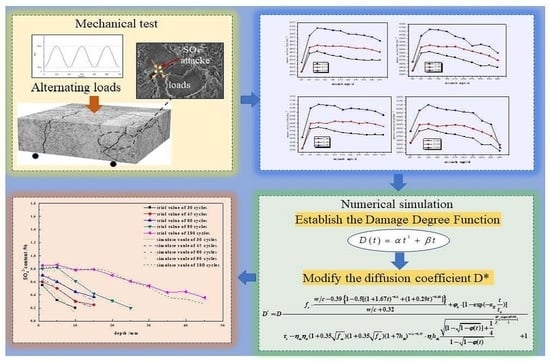Numerical Simulation of Concrete Attacked by Sulfate under Drying–Wetting Cycles Coupled with Alternating Loads
Abstract
1. Introduction
2. Materials and Methods
2.1. Materials
2.2. Concrete Mixing Ratio
2.3. Testing Methods
2.3.1. Experiment on Sulfate Attack of Concrete under Drying–Wetting Cycles Coupled with Alternating Loads
2.3.2. Sulfate Concentration Test
3. Analysis, Mathematical Derivation, and Simulation
3.1. Ultrasonic Wave Velocity Test
3.2. Establishment of Damage Degree Function
3.3. Concrete Porosity Correction Based on Damage Degree
3.4. Modification of the SO42− Diffusion Coefficient D*
3.5. Simulation of SO42− Distribution in Concrete under Drying–Wetting Cycles Coupled with Alternating Loads
4. Conclusions
- (1)
- As demonstrated by the ultrasonic wave velocity test, the drying–wetting cycles played an important part in the attack process of concrete induced by sulfate with a low sulfate concentration. The effect of the drying–wetting cycles with a high sulfate concentration coupled with the alternating loads with a high stress level caused the concrete to deteriorate faster and to a higher degree under sulfate attack.
- (2)
- We constructed a damage degree function of the concrete attacked by sulfate under drying–wetting cycles coupled with alternating loads using ultrasonic wave velocity testing and the concept of the relative elastic modulus, and we determined the key coefficients and by fitting the results.
- (3)
- In relation to the damage degree function, we modified the change function of the concrete porosity under drying–wetting cycles and alternating loads. Additionally, we modified the diffusion coefficient of SO42− in conjunction with the concept of tortuosity. We numerically simulated the distribution of SO42− in concrete, and the calculated results fitted well with the experimental data.
- (4)
- The model for the prediction of concrete sulfate attack depth under drying–wetting cycles coupled with alternating loads was developed. This model considers the effect of traffic loading and provides a complement to the study of the damage theory of concrete in complex environments.
Author Contributions
Funding
Data Availability Statement
Conflicts of Interest
References
- Zuo, X.; Sun, W. Full process analysis of damage and failure of concrete subjected to external sulfate attack. J. Chin. Ceram. Soc. 2009, 37, 1063–1067. [Google Scholar]
- Gao, R.; Zhao, S.; Li, Q.; Chen, J. Experimental study of the deterioration mechanism of concrete under sulfate attack in wet-dry cycles. China Civ. Eng. J. 2010, 43, 48–54. [Google Scholar]
- Zhang, H.; Shen, Z.; Xu, L.; Gan, L.; Liu, D.; Wu, Q.; Tan, J.; Sun, Y.; Ma, Z. Experimental and theoretical investigation on hydraulic fracturing in cement mortar exposed to sulfate attack. Mater. Des. 2022, 223, 111226. [Google Scholar] [CrossRef]
- Wang, Z.; Sun, P.; Zuo, J.; Liu, C.; Han, Y.; Zhang, Z. Long-term properties and microstructure change of engineered cementitious composites subjected to high sulfate coal mine water in drying-wetting cycles. Mater. Des. 2021, 203, 109610. [Google Scholar] [CrossRef]
- Ikumi, T.; Cavalaro, S.H.P.; Segura, I.; de la Fuente, A.; Aguado, A. Simplified methodology to evaluate the external sulfate attack in concrete structures. Mater. Des. 2016, 89, 1147–1160. [Google Scholar] [CrossRef]
- Jin, Z.; Sun, W.; Zhang, Y.; Jiang, J.; Lai, J. Interaction between sulfate and chloride solution attack of concretes with and without fly ash. Cem. Concr. Res. 2007, 37, 1223–1232. [Google Scholar] [CrossRef]
- Gao, J.; Yu, Z.; Song, L.; Wang, T.; Wei, S. Durability of concrete exposed to sulfate attack under flexural loading and drying–wetting cycles. Constr. Build. Mater. 2013, 39, 33–38. [Google Scholar] [CrossRef]
- Bonakdar, A.; Mobasher, B. Multi-parameter study of external sulfate attack in blended cement materials. Constr. Build. Mater. 2010, 24, 61–70. [Google Scholar] [CrossRef]
- Zhao, L.; Liu, J.; Zhou, W.; Ji, H. Damage evolution and mechanism of concrete erosion at sulfate environment in underground mine. J. China Coal Soc. 2016, 41, 1422–1428. [Google Scholar]
- Wang, H.-L.; Dong, Y.-S.; Sun, X.-Y.; Jin, W.-L. Damage mechanism of concrete deteriorated by sulfate attack in wet-dry cycle environment. J. Zhejiang Univ. Eng. Sci. 2012, 46, 1255–1261. [Google Scholar] [CrossRef]
- Yuan, X.; Li, B.; Cui, G.; Zhao, S.; Zhou, M. Effect of mineral admixtures on durability of concrete in wetting-drying cyclic sulfate environment. J. Chin. Ceram. Soc. 2009, 37, 1754–1759. [Google Scholar]
- Yoshida, N.; Matsunami, Y.; Nagayama, M.; Sakai, E. Salt Weathering in Residential Concrete Foundations Exposed to Sulfate-bearing Ground. J. Adv. Concr. Technol. 2010, 8, 121–134. [Google Scholar] [CrossRef]
- Kim, S.-S.; Lee, S.-T. Microstructural observations on the deterioration of concrete structure for sewage water treatment. KSCE J. Civ. Eng. 2010, 14, 753–758. [Google Scholar] [CrossRef]
- Davalos, J.F.; Kodkani, S.S.; Ray, I.; Chunfu, L. Fracture evaluation of GFRP-concrete interfaces for freeze-thaw and wet-dry cycling. J. Compos. Mater. 2008, 42, 1439–1466. [Google Scholar] [CrossRef]
- Ababneh, A.; Sheban, M. Impact of mechanical loading on the corrosion of steel reinforcement in concrete structures. Mater. Struct. 2011, 44, 1123–1137. [Google Scholar] [CrossRef]
- Ting, M.Z.Y.; Wong, K.S.; Rahman, M.E.; Meheron, S.J. Deterioration of marine concrete exposed to wetting-drying action. J. Clean. Prod. 2021, 278, 123383. [Google Scholar] [CrossRef]
- Cheng, H.; Liu, T.; Zou, D.; Zhou, A. Compressive strength assessment of sulfate-attacked concrete by using sulfate ions distributions. Constr. Build. Mater. 2021, 293, 123550. [Google Scholar] [CrossRef]
- Wang, K.; Guo, J.; Yang, L.; Zhang, P.; Xu, H. Multiphysical damage characteristics of concrete exposed to external sulfate attack: Elucidating effect of drying–wetting cycles. Constr. Build. Mater. 2022, 329, 127143. [Google Scholar] [CrossRef]
- Yin, Y.; Hu, S.; Lian, J.; Liu, R. Fracture properties of concrete exposed to different sulfate solutions under drying-wetting cycles. Eng. Fract. Mech. 2022, 266, 108406. [Google Scholar] [CrossRef]
- Yin, G.J.; Zuo, X.B.; Tang, Y.J.; Ayinde, O.; Ding, D.N. Modeling of time-varying stress in concrete under axial loading and sulfate attack. Comput. Concr. 2017, 19, 143–152. [Google Scholar] [CrossRef]
- Bowen, G.; Wenjin, D.; Faping, W. Damage of concrete subjected to sulfate corrosion under dry-wet cycles and alternating loads. J. Jilin Univ. (Eng. Technol. Ed.) 2022, 1–10. [Google Scholar] [CrossRef]
- Liu, F.; You, Z.; Diab, A.; Liu, Z.; Zhang, C.; Guo, S. External sulfate attack on concrete under combined effects of flexural fatigue loading and drying-wetting cycles. Constr. Build. Mater. 2020, 249, 118224. [Google Scholar] [CrossRef]
- Liu, P.; Chen, Y.; Wang, W.; Yu, Z. Effect of physical and chemical sulfate attack on performance degradation of concrete under different conditions. Chem. Phys. Lett. 2020, 745, 137254. [Google Scholar] [CrossRef]
- Ikumi, T.; Segura, I. Numerical assessment of external sulfate attack in concrete structures. A review. Cem. Concr. Res. 2019, 121, 91–105. [Google Scholar] [CrossRef]
- Jiang, L.; Niu, D. Study of deterioration of concrete exposed to different types of sulfate solutions under drying-wetting cycles. Constr. Build. Mater. 2016, 117, 88–98. [Google Scholar] [CrossRef]
- Jokūbaitis, A.; Marčiukaitis, G.; Valivonis, J. Influence of technological and environmental factors on the behaviour of the reinforcement anchorage zone of prestressed concrete sleepers. Constr. Build. Mater. 2016, 121, 507–518. [Google Scholar] [CrossRef]
- Shao, W.; Shi, D. Numerical Simulation of Degradation Behavior of Concrete Piles in Sulfate Saline Soils. KSCE J. Civ. Eng. 2022, 26, 183–192. [Google Scholar] [CrossRef]
- Wang, H.; Chen, Z.; Li, H.; Sun, X. Numerical simulation of external sulphate attack in concrete considering coupled chemo-diffusion-mechanical effect. Constr. Build. Mater. 2021, 292, 123325. [Google Scholar] [CrossRef]
- Sun, C.; Chen, J.; Zhu, J.; Zhang, M.; Ye, J. A new diffusion model of sulfate ions in concrete. Constr. Build. Mater. 2013, 39, 39–45. [Google Scholar] [CrossRef]
- Yi, C.; Chen, Z.; Bindiganavile, V. A non-homogeneous model to predict the service life of concrete subjected to external sulphate attack. Constr. Build. Mater. 2019, 212, 254–265. [Google Scholar] [CrossRef]
- Zuo, X.-B.; Sun, W.; Yu, C. Numerical investigation on expansive volume strain in concrete subjected to sulfate attack. Constr. Build. Mater. 2012, 36, 404–410. [Google Scholar] [CrossRef]
- Yin, G.-J.; Zuo, X.-B.; Tang, Y.-J.; Ayinde, O.; Wang, J.-L. Numerical simulation on time-dependent mechanical behavior of concrete under coupled axial loading and sulfate attack. Ocean Eng. 2017, 142, 115–124. [Google Scholar] [CrossRef]
- Li, J.; Xie, F.; Zhao, G.; Li, L. Experimental and numerical investigation of cast-in-situ concrete under external sulfate attack and drying-wetting cycles. Constr. Build. Mater. 2020, 249, 118789. [Google Scholar] [CrossRef]
- Zhang, C.-L.; Chen, W.-K.; Mu, S.; Savija, B.; Liu, Q.-F. Numerical investigation of external sulfate attack and its effect on chloride binding and diffusion in concrete. Constr. Build. Mater. 2021, 285, 122806. [Google Scholar] [CrossRef]
- Wang, J.; Ng, P.-L.; Wang, W.; Du, J.; Song, J. Modelling chloride diffusion in concrete with influence of concrete stress state. J. Civ. Eng. Manag. 2017, 23, 955–965. [Google Scholar] [CrossRef][Green Version]
- Du, X.; Jin, L.; Zhang, R. Meso-scale Simulation of Chloride Diffusivity in Concrete Subjected to Compressive Stress. J. Build. Mater. 2016, 19, 65–71. [Google Scholar]
- Jin, L.; Zhang, R.; Du, X.; Li, Y. Multi-scale analytical theory of the diffusivity of concrete subjected to mechanical stress. Constr. Build. Mater. 2015, 95, 171–185. [Google Scholar] [CrossRef]
- Bonakdar, A.; Mobasher, B.; Chawla, N. Diffusivity and micro-hardness of blended cement materials exposed to external sulfate attack. Cem. Concr. Compos. 2012, 34, 76–85. [Google Scholar] [CrossRef]
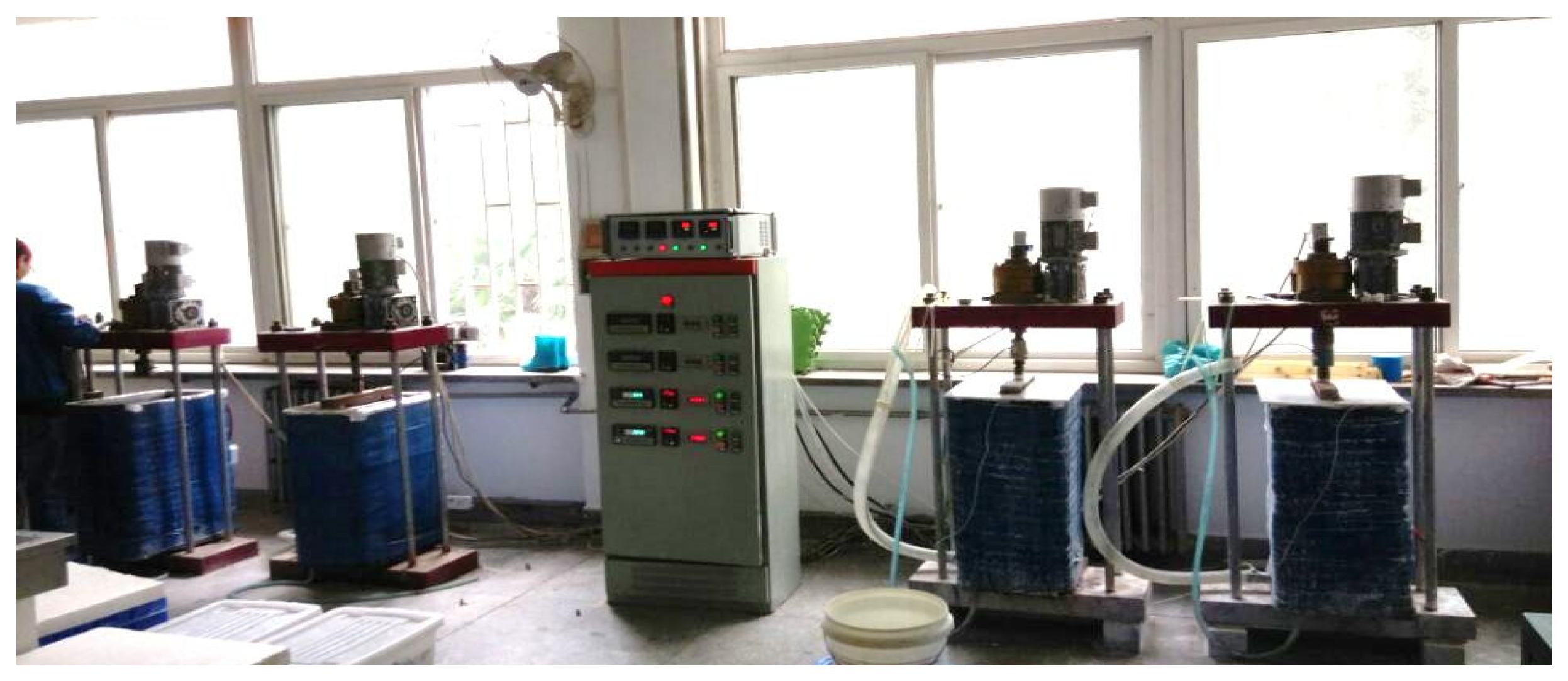

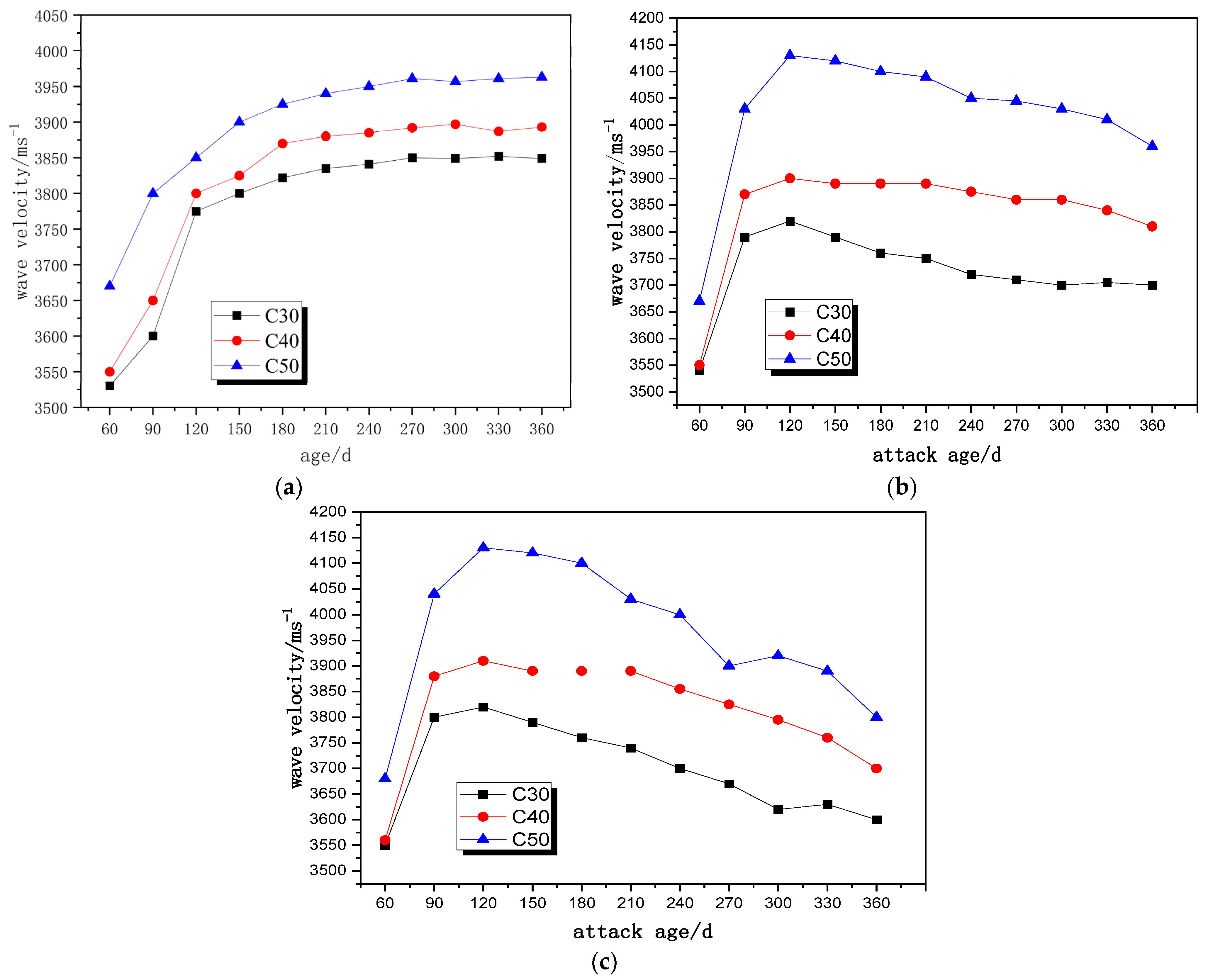

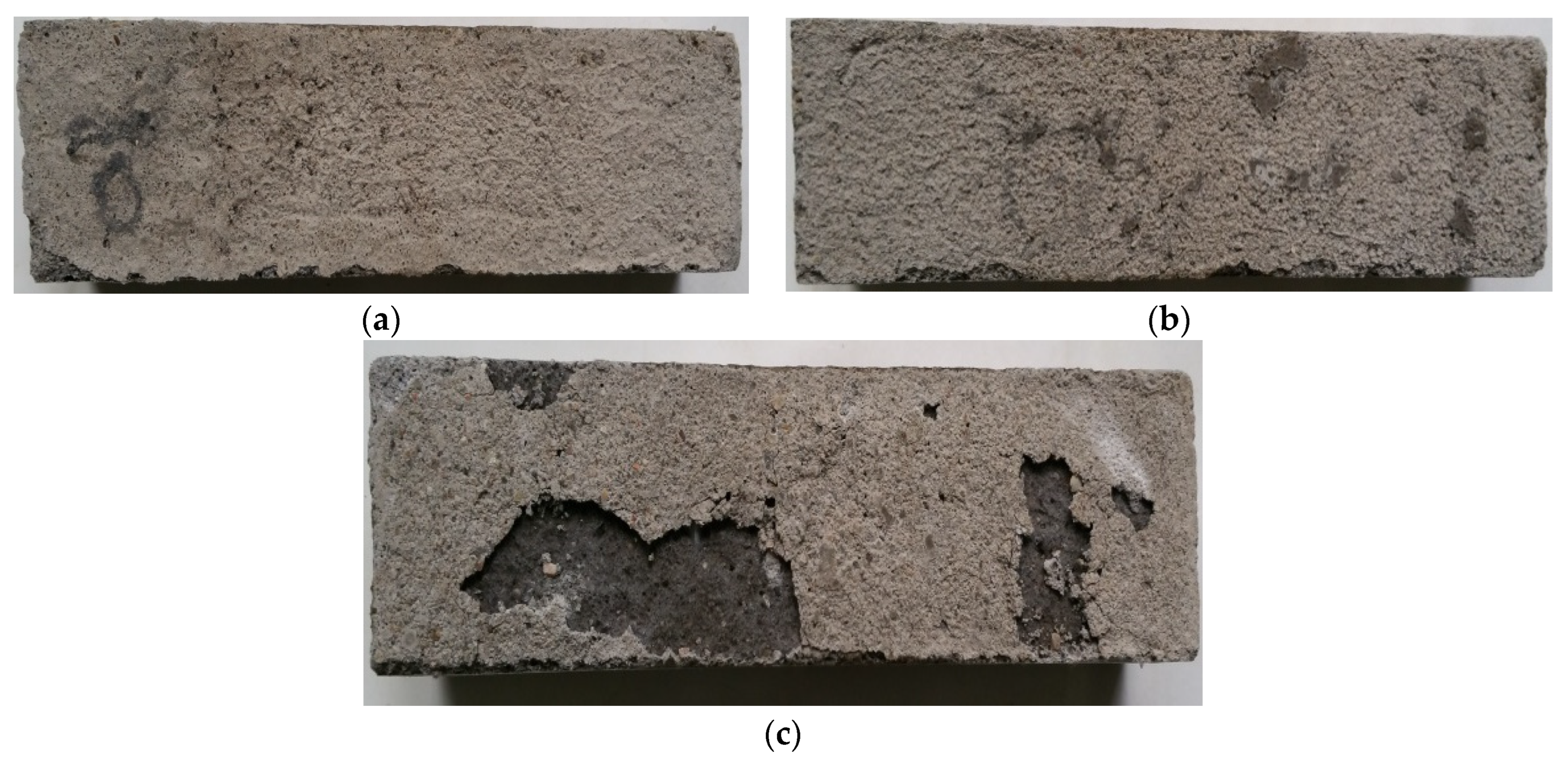
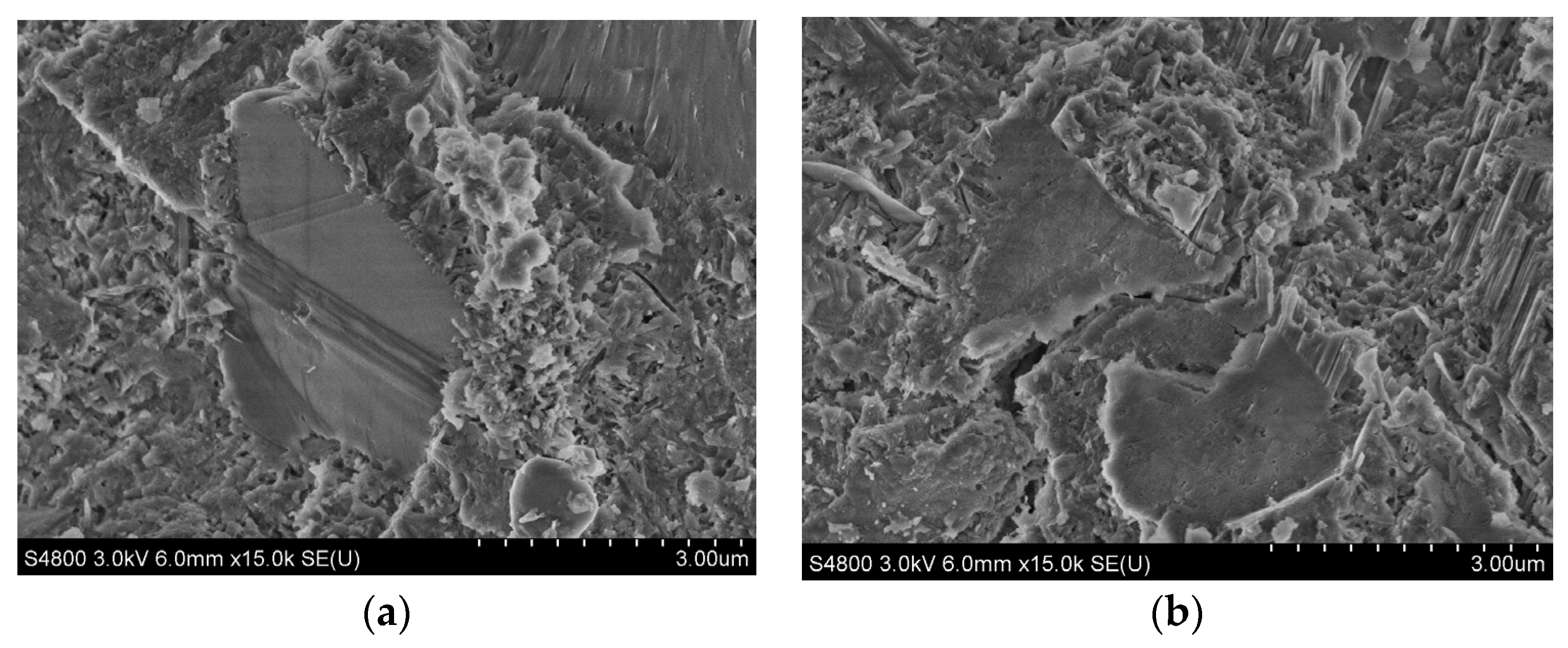
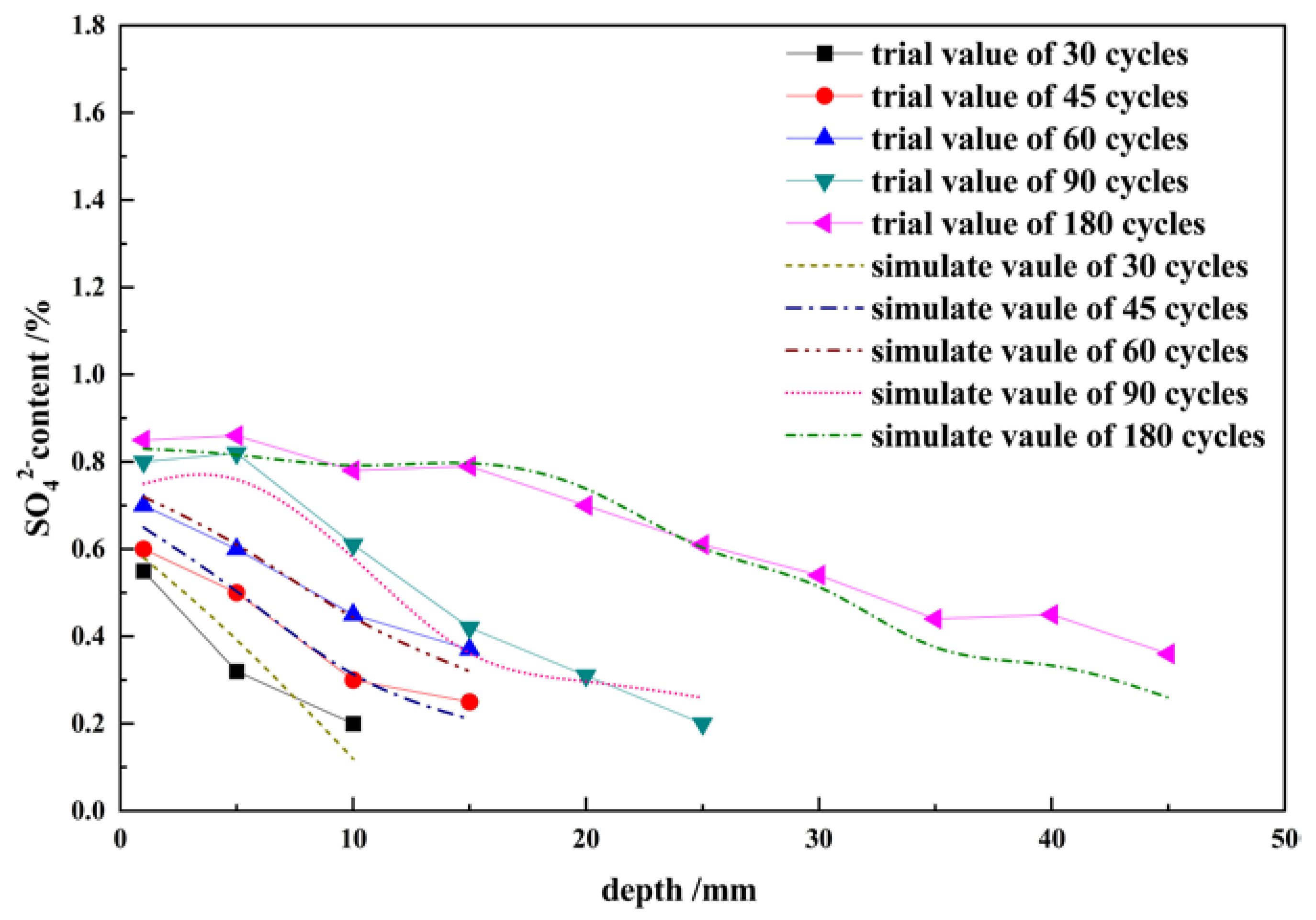
| SiO2 | Al2O3 | Fe2O3 | CaO | MgO | SO3 | Na2Oeq | LOSS | f-CaO |
|---|---|---|---|---|---|---|---|---|
| 21.01 | 4.55 | 2.99 | 62.4 | 1.79 | 2.93 | 0.58 | 3.14 | 0.61 |
| Density (kg/m3) | Crushing Value (%) | Water Absorption (%) | Elongated Particle Content (%) |
|---|---|---|---|
| 2699 | 9.41 | 1.37 | 3.6 |
| Strength Grade | Water (kg/m3) | Cement (kg/m3) | Fine Aggregate (kg/m3) | Coarse Aggregate (kg/m3) | Water Reducer (%) | w/c |
|---|---|---|---|---|---|---|
| C50 | 145 | 518 | 506 | 1281 | 1.4 | 0.28 |
| C40 | 202 | 505 | 593 | 1150 | / | 0.40 |
| C30 | 193 | 357 | 691 | 1159 | / | 0.55 |
| w/c | w/c | |||||||
|---|---|---|---|---|---|---|---|---|
| Concentration | 0.28 | 0.40 | 0.55 | R2 | 0.28 | 0.40 | 0.55 | R2 |
| 5% | 0.0742 | 0.0541 | 0.0741 | 0.9632 | 0.1647 | 0.5789 | 0.0468 | 0.9125 |
| 10% | 0.1325 | 0.0698 | 0.1362 | 0.9421 | 1.2465 | 0.4621 | 0.6987 | 0.9368 |
| w/c | w/c | |||||||
|---|---|---|---|---|---|---|---|---|
| Concentration | 0.28 | 0.40 | 0.55 | R2 | 0.28 | 0.40 | 0.55 | R2 |
| 5% | 0.0734 | 0.0612 | 0.0816 | 0.9457 | 0.1467 | 0.5814 | 0.0519 | 0.9632 |
| 10% | 0.1065 | 0.0715 | 0.1679 | 0.9682 | 1.3914 | 0.4139 | 0.7145 | 0.9528 |
Disclaimer/Publisher’s Note: The statements, opinions and data contained in all publications are solely those of the individual author(s) and contributor(s) and not of MDPI and/or the editor(s). MDPI and/or the editor(s) disclaim responsibility for any injury to people or property resulting from any ideas, methods, instructions or products referred to in the content. |
© 2022 by the authors. Licensee MDPI, Basel, Switzerland. This article is an open access article distributed under the terms and conditions of the Creative Commons Attribution (CC BY) license (https://creativecommons.org/licenses/by/4.0/).
Share and Cite
Guan, B.; Zhang, S.; Wang, F.; Wu, J.; Li, L. Numerical Simulation of Concrete Attacked by Sulfate under Drying–Wetting Cycles Coupled with Alternating Loads. Buildings 2023, 13, 82. https://doi.org/10.3390/buildings13010082
Guan B, Zhang S, Wang F, Wu J, Li L. Numerical Simulation of Concrete Attacked by Sulfate under Drying–Wetting Cycles Coupled with Alternating Loads. Buildings. 2023; 13(1):82. https://doi.org/10.3390/buildings13010082
Chicago/Turabian StyleGuan, Bowen, Shuowen Zhang, Faping Wang, Jiayu Wu, and Lingyun Li. 2023. "Numerical Simulation of Concrete Attacked by Sulfate under Drying–Wetting Cycles Coupled with Alternating Loads" Buildings 13, no. 1: 82. https://doi.org/10.3390/buildings13010082
APA StyleGuan, B., Zhang, S., Wang, F., Wu, J., & Li, L. (2023). Numerical Simulation of Concrete Attacked by Sulfate under Drying–Wetting Cycles Coupled with Alternating Loads. Buildings, 13(1), 82. https://doi.org/10.3390/buildings13010082




